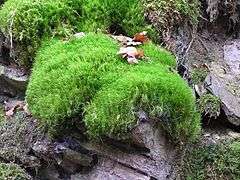Dicranum scoparium
| Dicranum scoparium Broom forkmoss | |
|---|---|
| | |
| Broom moss in Lake Superior Provincial Park, Ontario | |
| Scientific classification | |
| Kingdom: | Plantae |
| Division: | Bryophyta |
| Class: | Bryopsida |
| Subclass: | Dicranidae |
| Order: | Dicranales |
| Family: | Dicranaceae |
| Genus: | Dicranum |
| Species: | D. scoparium |
| Binomial name | |
| Dicarnum scoparium Hedw. | |
Dicranum scoparium, the broom forkmoss,[1] is a species of dicranid moss, native to North America, including the Great Lakes region. It usually forms tufts or mats on soil in dry to moist forested areas. Broom moss can be distinguished by its leaves, which strongly curve to one side.
Description
Broom forkmoss is usually robust and coarse, forming shiny tufts with woolly stems 2–8 cm high. The leaf midrib extends to the tip and usually has 4 ridges along its back. The leaves are 3.5–8 mm long, lance-shaped with a long, slender point, and strongly toothed along the upper third. Most leaves will be folded and curved to one side, but may be wavy. Capsules are 2.3–5 mm long, urn-shaped and curved. The capsules are held on mostly-erect stalks 18–35 mm long. The operculum (capsule lid) is usually longer than the capsule.[2]
Distribution
Broom forkmoss can be found across North America (except Labrador, North Dakota, Texas and Nevada), Europe, Asia, as well as in Australia and New Zealand[3]
Gallery


 Capsules
Capsules Close-up
Close-up Lamina cells 400×
Lamina cells 400× Middle ridge 200×
Middle ridge 200×
References
| Wikimedia Commons has media related to Dicranum scoparium. |
- ↑ Edwards, Sean R. (2012). English Names for British Bryophytes. British Bryological Society Special Volume. 5 (4 ed.). Wootton, Northampton: British Bryological Society. ISBN 978-0-9561310-2-7. ISSN 0268-8034.
- ↑ Legasy, K., LaBelle-Beadman, S. & Chambers, B. 1995. Forest Plants of Northeastern Ontario. Lone Pine Publishing & Queen's Printer for Ontario: Edmonton. ISBN 1-55105-064-1
- ↑ Flora of North America. n.d. Dicranum scoparium Hedw.